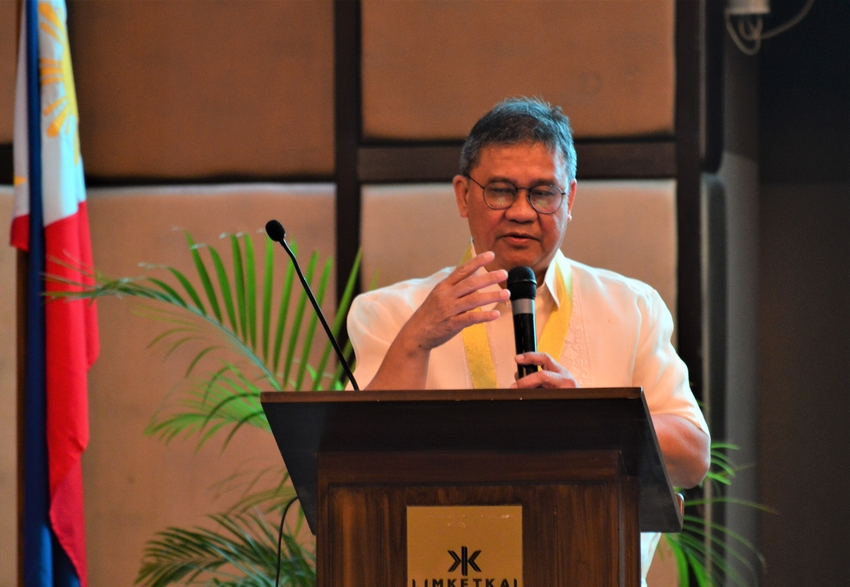
Department of Science and Technology-10 (DOST-10) regional director Alfonso Alamban tells participants of the Innovation Forum organized by the University of Science and Technology of Southern Philippines held at a hotel here recently that the region is being developed as the innovation hub of Mindanao. (Jigger J. Jerusalem/davaotoday.com)
CAGAYAN DE ORO CITY, Philippines – Various initiatives at promoting the endeavors of local students and entrepreneurs is making Northern Mindanao the innovation hub of Mindanao, a Department of Science and Technology-10 (DOST-10) official said.
That vision would soon become a reality, said Alfonso Alamban, DOST-10 regional director, as Northern Mindanao has been considered as four of the pilot regions for inclusive innovation hub in the country, which will provide support to the innovation ecosystem so new technologies could be developed and promoted.
Alamban was the keynote speaker of the Innovation Forum and Roundtable Discussion organized by the University of Science and Technology of Southern Philippines (USTP) in a hotel here on Thursday.
The regional director talked about how vital science, technology, and innovation are to the competitiveness and the economic growth of a country to dozens of participants that included representatives from the academe, private and government sectors, as well as students and innovators.
Alamban said the region is ripe for a much-needed transformation as the breeding ground for technological and entrepreneurial advancement given the atmosphere of innovation cultivated mostly by local academic institutions.
“We have a responsive business sector, what we need to do is really support them (innovators),” Alamban said on the sideline of the forum.
Among the many innovations that are gaining the recognition in the region, he said, is on food processing.
“We are initially looking at enhancing the food innovation center at USTP. There are a number of food products developed already, and the challenge now is to have a more appropriate equipment for commercial production,” he added.
Aside from food innovation, there are also a few technologies being introduced by local developers, such as Streetby, an application that provides easy access for making hotel and dining reservations and other online activities.
Another challenge that institutions such as DOST and USTP are addressing is on the research and development (R&D) aspect of product innovation.
“What we’re pushing [is] we have to develop the innovation capability which would come from research and development, but we will not stop with R&D. We will also try to utilize and commercialize the results of R&D,” he said.
Most of the research and development works are being conducted in universities but budget limitations may be feared to hinder the further R&D efforts, he said.
“We have to have more resources poured into research and development. That has been our battle cry at
Congress,” Alamban said, adding that tertiary schools with R&D may have to make do with what they have as government funding may be slashed for next year’s research and development program.
For this year, he noted, about P20 billion was allocated for R&D. With the cut in the 2019 budget, funding for research and development may be slashed as well.
Although the fund for R&D is not enough, Alamban said, “at least we now have resources” distributed to educational institutions that are doing research and development like the Mindanao State University-Iligan Institute of Technology, Xavier University, USTP, among others.
Bronson Mabulay, head of the Center for Entrepreneurship and Technology (CET) at USTP, said schools play an important role in developing potential entrepreneurs who may be working on an innovative idea.
“The old mindset is changing,” Mabulay said, referring to the long-held belief that students go to school to learn and get a job after finishing school.
Inside the confines of the campus, he said that students can explore and experience failure, and although they may fail a few times, the failure can teach them to hone their skills to come up with a better application for their ideas.
For Ericke Rafael Gallardo, 23, an Information Technology at USTP, the CET has helped him come up with a technology that allows students and professionals to use their smartphones without charging it.
Taking into consideration that smartphones have shorter battery life, Gallardo’s thought up of a simple and proven technology to ensure that individuals who are always on their phones such as him don’t experience the hassle of having to plug in every time their gadgets’ battery goes low.
He said his invention was the result of the frustration he shares with most people his age who use their phones to connect with others online and to play games.
Calling his innovation “BFree,” Gallardo made a cellphone casing that houses a spare lithium ion battery which he can remove and insert a new one once it’s drained.
The used battery will then be charged using a special charger, which he will include as part of the “BFree” package.
“I’ve been using my phone for four months now without charging,” the IT student said, who started putting his idea to good use in July.
Now that he has the product, Gallardo said he needs funding from government or private entities “so we could mass produce and sell our products.” (davaotoday.com)










